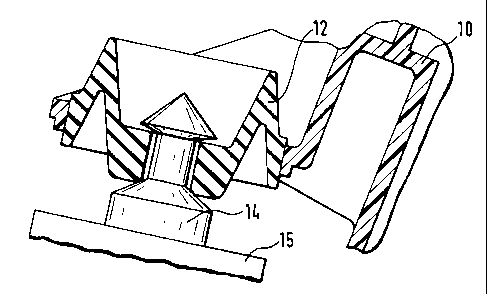Some of the information on this Web page has been provided by external sources. The Government of Canada is not responsible for the accuracy, reliability or currency of the information supplied by external sources. Users wishing to rely upon this information should consult directly with the source of the information. Content provided by external sources is not subject to official languages, privacy and accessibility requirements.
Any discrepancies in the text and image of the Claims and Abstract are due to differing posting times. Text of the Claims and Abstract are posted:
| (12) Patent: | (11) CA 2227816 |
|---|---|
| (54) English Title: | FASTENING ELEMENT |
| (54) French Title: | ELEMENT DE FIXATION |
| Status: | Expired and beyond the Period of Reversal |
| (51) International Patent Classification (IPC): |
|
|---|---|
| (72) Inventors : |
|
| (73) Owners : |
|
| (71) Applicants : |
|
| (74) Agent: | NORTON ROSE FULBRIGHT CANADA LLP/S.E.N.C.R.L., S.R.L. |
| (74) Associate agent: | |
| (45) Issued: | 2007-08-28 |
| (86) PCT Filing Date: | 1996-05-15 |
| (87) Open to Public Inspection: | 1997-02-06 |
| Examination requested: | 2003-05-15 |
| Availability of licence: | N/A |
| Dedicated to the Public: | N/A |
| (25) Language of filing: | English |
| Patent Cooperation Treaty (PCT): | Yes |
|---|---|
| (86) PCT Filing Number: | PCT/EP1996/002089 |
| (87) International Publication Number: | WO 1997003801 |
| (85) National Entry: | 1998-01-26 |
| (30) Application Priority Data: | ||||||
|---|---|---|---|---|---|---|
|
A fastening element for a plastic housing, especially a filter housing,
which is fitted to a supporting structure so as to damp vibrations. To this
end
the housing is provided with a fastening element comprising a rubber-elastic
member, especially a member produced by the two-component injection molding
method, and a mounting member of the support structure is lockingly engaged
with the fastening element so that the fastening element of the housing is
functionally connected to the supporting structure.
L'invention concerne un élément de fixation destiné à un boîtier en matière plastique, notamment un boîtier à filtre. Un tel boîtier est notamment monté sur une structure de fixation de façon que les vibrations soient amorties. A cet effet, une zone de fixation est prévue à l'intérieur du boîtier avec, dans cette zone, un élément ayant l'élasticité du caoutchouc (12), notamment un élément réalisé selon la technique de moulage par injection à deux composantes. Cet élément est relié de façon fonctionnelle à la structure de fixation (27).
Note: Claims are shown in the official language in which they were submitted.
Note: Descriptions are shown in the official language in which they were submitted.

2024-08-01:As part of the Next Generation Patents (NGP) transition, the Canadian Patents Database (CPD) now contains a more detailed Event History, which replicates the Event Log of our new back-office solution.
Please note that "Inactive:" events refers to events no longer in use in our new back-office solution.
For a clearer understanding of the status of the application/patent presented on this page, the site Disclaimer , as well as the definitions for Patent , Event History , Maintenance Fee and Payment History should be consulted.
| Description | Date |
|---|---|
| Time Limit for Reversal Expired | 2014-05-15 |
| Letter Sent | 2013-05-15 |
| Grant by Issuance | 2007-08-28 |
| Inactive: Cover page published | 2007-08-27 |
| Inactive: Final fee received | 2007-06-07 |
| Pre-grant | 2007-06-07 |
| Notice of Allowance is Issued | 2007-03-06 |
| Letter Sent | 2007-03-06 |
| Notice of Allowance is Issued | 2007-03-06 |
| Inactive: Approved for allowance (AFA) | 2007-02-19 |
| Amendment Received - Voluntary Amendment | 2006-12-20 |
| Inactive: S.30(2) Rules - Examiner requisition | 2006-12-06 |
| Amendment Received - Voluntary Amendment | 2006-06-20 |
| Inactive: IPC from MCD | 2006-03-12 |
| Inactive: IPC from MCD | 2006-03-12 |
| Inactive: S.30(2) Rules - Examiner requisition | 2005-12-23 |
| Inactive: First IPC assigned | 2003-07-18 |
| Letter Sent | 2003-06-12 |
| Request for Examination Requirements Determined Compliant | 2003-05-15 |
| All Requirements for Examination Determined Compliant | 2003-05-15 |
| Amendment Received - Voluntary Amendment | 2003-05-15 |
| Request for Examination Received | 2003-05-15 |
| Inactive: Adhoc Request Documented | 2002-12-05 |
| Request for Examination Received | 2002-10-24 |
| Classification Modified | 1998-05-07 |
| Inactive: IPC assigned | 1998-05-07 |
| Inactive: First IPC assigned | 1998-05-07 |
| Inactive: IPC assigned | 1998-05-07 |
| Inactive: Notice - National entry - No RFE | 1998-04-23 |
| Application Received - PCT | 1998-04-20 |
| Amendment Received - Voluntary Amendment | 1998-01-27 |
| Amendment Received - Voluntary Amendment | 1998-01-26 |
| Application Published (Open to Public Inspection) | 1997-02-06 |
There is no abandonment history.
The last payment was received on 2007-04-20
Note : If the full payment has not been received on or before the date indicated, a further fee may be required which may be one of the following
Patent fees are adjusted on the 1st of January every year. The amounts above are the current amounts if received by December 31 of the current year.
Please refer to the CIPO
Patent Fees
web page to see all current fee amounts.
Note: Records showing the ownership history in alphabetical order.
| Current Owners on Record |
|---|
| FILTERWERK MANN & HUMMEL GMBH |
| Past Owners on Record |
|---|
| MARIO RIEGER |